Big Dog, Bigger Love: My Gentle Giant Era
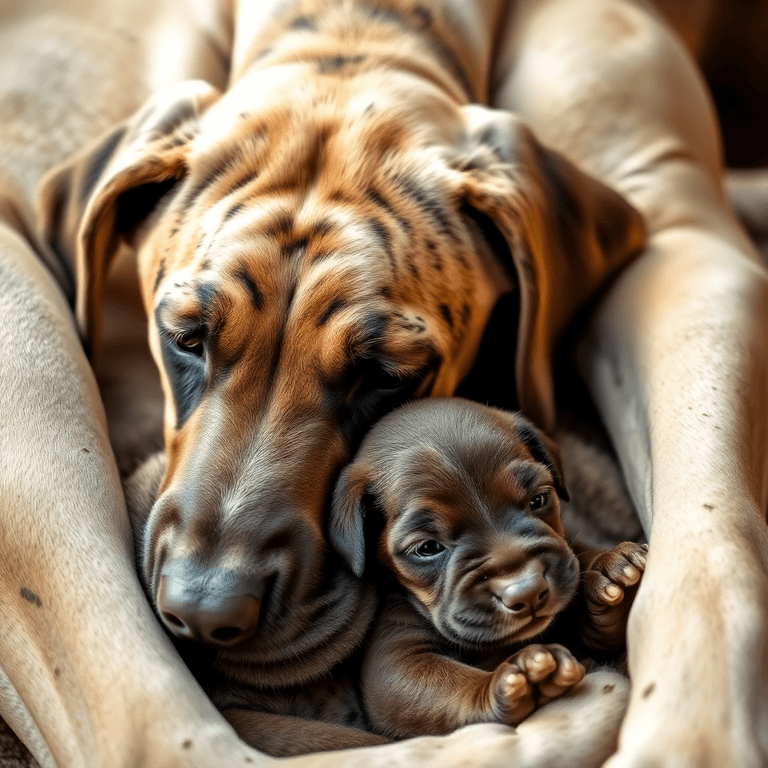
Development Stages of Great Danes
Woof! Let me tell you about how us Great Danes grow up – it’s quite the adventure!
First came my neonatal days (a fancy term for newborn) from birth to 2 weeks old. Boy, was I helpless! I couldn’t even keep myself warm and had to snuggle with Mom constantly. I was basically a furry potato that wiggled and whined for milk.
Then things got exciting during my changeover stage from 2 to 12 weeks. My eyes finally opened – what a bright world! This is when I learned super important stuff like how to play nicely with humans and other dogs. Trust me, you don’t want to skip this part or you’ll end up being that awkward dog at the park.
Next came my rapid juvenile growth from 2 to 6 months – and wow, did I grow FAST! I packed on 2 to 4 pounds every single week. My humans kept buying me bigger collars, and I kept outgrowing them before they could even remove the tags. It was like I was inflating like a balloon, except fluffier and with more slobber.
Adolescence hit me hard from 6 to 12 months. Suddenly, my brain got all weird and developed something my humans called “selective hearing.” When they said “come,” I heard “chase that squirrel!” When they said “sit,” I heard “time to investigate that interesting smell over there!” Oops.
During my late juvenile phase from 12 to 18 months, my humans had to change my food again. Growing into a gentle giant requires special nutrition. Who knew being huge was so complicated?
Finally, at the age of two, I reached full maturity. My growth plates sealed up tight, and I stopped acting like a crazy puppy all the time. Well, mostly. I still get pretty excited about squirrels.
Key Takeaways
My Life as a Great Dane: From Tiny Pup to Gentle Giant
Hi there! I’m a Great Dane, and let me tell you about my crazy journey from a tiny puppy to the giant dog I am today!
When I was first born, I was totally helpless. Can you believe it? I couldn’t see or hear anything! All I could do was snuggle up to my mom for warmth and drink her milk every two to three hours. Those first two weeks were spent primarily on eating and sleeping. Not a bad life, if you ask me!
Then something amazing happened when I turned 2 weeks old – my eyes and ears finally opened! Suddenly, the world was full of sights and sounds. This was when I started meeting humans, and wow, they were tall! Well, not as tall as I’d eventually become, but still pretty big to a little pup like me. The humans told me this was super important for learning how to be friendly, and it lasted until I was 12 weeks old.
From 2 to 6 months old, I grew like crazy! I’m talking 2-4 pounds every single week. My human family kept having to buy me bigger collars and beds. It was wild! My bones were growing so fast that my growth plates were working overtime to turn into real bone. I felt like I was getting taller every day – because I was!
Then came my teenage months from 6 to 18 months old. Oh boy, was I a handful! Just like human teenagers, I thought I knew everything and liked to test the rules. “Sit? Maybe I will, maybe I won’t!” However, my brain was also becoming smarter during this time, so I gradually learned to make better choices.
Finally, at the age of 2, I reached my full size and became the calm, gentle giant everyone talks about. No more growing, no more being a troublemaker – just me being the best, most obedient dog I could be. And let me tell you, being this tall has its perks – I can see everything from up here!
Neonatal and Early Puppy Stage (Birth to 2 Weeks)
Woof! Let me tell you about my first two weeks as a tiny Great Dane puppy – though I wasn’t so great or Dane-like back then!
When I was born, I was basically a helpless little sausage with legs. Can you believe I couldn’t even open my eyes or ears? Talk about being born unprepared! I’d to rely on my super nose and sense of touch to wiggle around and find Mom. It was like playing the world’s most crucial game of blind man’s bluff, except the prize was dinner!
Speaking of dinner, wow was I hungry! I needed to eat every 2-3 hours around the clock. Poor Mom barely got any sleep because I was always nudging her for a drink of milk. But hey, a growing Great Dane’s gotta eat! I was supposed to gain about 5-10% of my weight every single day. That’s like a human kid gaining several pounds daily – imagine that grocery bill!
The worst part? I was a total wimp when it came to staying warm. I couldn’t control my body temperature at all, so I’d snuggle super close to Mom or huddle under heat lamps to keep my body at the right temperature. Without that warmth, I’d have been in big trouble.
My belly button cord thing fell off around day seven, which was pretty gross but totally normal.
And slowly but surely, my reflexes got better at finding food and staying safe. Interestingly, during this neonatal stage, I spent about 90% of my time sleeping to support my rapid growth. Looking back, those first two weeks were all about eating, sleeping, staying warm, and growing as fast as possible!
Transitional and Socialization Stage (2 to 12 Weeks)
Hey there, humans! Let me tell you what it’s like when us Great Dane puppies start growing up. When we hit two weeks old, something amazing happens – our eyes pop open for the first time! It’s like someone turned on the lights in a dark room. Our ears start working too, so suddenly we can hear Mom barking and our brothers and sisters making all sorts of funny noises.
Our brains become increasingly busy during this time. It’s like having a computer that suddenly gets way faster! We begin figuring out how to be proper dogs by wrestling with our littermates and watching our mom show us the ropes. She teaches us important stuff like how to play nice and not bite too hard – trust me, when you’re going to be as big as a small horse someday, you need to learn gentle manners early!
The coolest part is when humans start visiting us between 3 and 12 weeks old. Our puppy brains are like sponges soaking up everything new. Meeting people during this time helps us become the friendly giants we’re meant to be. Early exposure to new experiences is essential for our socialization and emotional development.
Scientists say this is super important for big dogs like us – we need to learn that humans are awesome friends, not scary strangers. It’s basically like going to puppy school, except way more fun with lots of belly rubs and treats!
Sensory Development Begins
Wow! Growing Up Is Like Getting Superpowers!
Hi there! Let me tell you about the coolest thing ever – how us Great Dane puppies get our amazing senses! It’s as if we’re superheroes, gaining new powers every day.
When I was tiny, I couldn’t see or hear anything. Can you believe that? I was like a furry little potato who could only smell and feel things. But then the magic started happening when I was about two weeks old!
First, my eyes opened up! It was as if someone had turned on the lights for the first time. Everything was blurry at first, kind of like looking through foggy windows. But wow, I could finally see my mom’s big face and my brothers and sisters wiggling around next to me.
A few days later, my ears popped open too! Suddenly, I could hear all these new sounds – my mom’s gentle woofs, my littermates making funny squeaky noises, and even the footsteps of humans walking around. It was like the world got twice as exciting!
The best part? I stopped falling over so much! Before, I’d tumble around like a fuzzy bowling ball. But with my new super senses working together, I could walk without looking like I was doing silly gymnastics.
My nose and tongue also improved at their jobs. I could taste more flavors and smell a million new smells. Plus, I could feel everything so much better with my paws and fur.
Now instead of just wiggling around randomly, I could play with my family and explore our little world. Growing up is pretty awesome when you’re a Great Dane puppy! Also, early socialization helps us build confidence and reduces fear-based behaviors, making training easier later on.
Early Social Skills
Learning to Be Social – A Great Dane’s Story
When I was very young (around 2-12 weeks old), my brain was growing extremely fast, and I was learning new things every single day. My eyes and ears started working, which was awesome because suddenly I could see my littermates and hear all the cool sounds around me!
Let me tell you what happened during those exciting weeks:
Weeks 2-3: “Hey, Who Are You?”
At first, I could barely tell my brothers and sisters apart. We mostly just slept and ate, but I began to recognize their smells and sounds. Playing wasn’t my thing yet – I was still figuring out how my huge paws worked!
Weeks 4-6: “I’ve Got Moves!”
This is when things got fun! My tail started wagging (and boy, does it pack a punch when you’re going to be as big as me). I learned different barks and whines to communicate my wants to everyone. My siblings and I started wrestling and gently biting each other – don’t worry, we weren’t being mean; we were learning!
Weeks 7-9: “I’m Getting Good at This!”
Now I was cooking! I figured out how to “speak” Great Dane properly and started understanding what other dogs were saying. I got obsessed with grabbing toys and chasing my littermates around the yard. Everything was a game!
Weeks 10-12: “Humans Are Pretty Cool Too!”
The best part was learning that humans could be my friends too! I started bonding with the people around me and learned to play more complicated games. Turns out humans are great at belly rubs! This early socialization experience is crucial for preventing aggression or dominance issues later in life.
All this early practice helped me become the friendly, well-behaved Great Dane I am today. Those first few months set me up for a lifetime of good friendships and fun!
Human Exposure Importance
Why Us Great Dane Puppies Need Our Human Friends
Hi there, and I want to share something extremely important about growing up big and strong, just like me. Between the ages of 2 weeks and 12 weeks, I need to spend time with humans. This time is like the most crucial part of my whole puppy life!
During these weeks, my brain is like a giant sponge soaking up everything around me. If I get to spend lots of time with my human friends, amazing things happen in my head! I become better at handling scary stuff, and I get smarter too. It’s as if my brain has special superpowers during this time, which help me learn about humans.
My favorite part is when humans give me daily cuddle sessions, which last about 15-20 minutes. I love when they pet me, talk to me in their funny human voices, and just hang around with me. These cuddle times make me feel happy and safe.
When I grow up to be a giant dog (and trust me, I’ll be HUGE!), I’ll remember these good feelings and won’t get nervous or scared as much.
But here’s the thing – if I don’t get enough human time during these special weeks, I might become a scaredy-cat. Well, not really a cat because I’m a dog, but you know what I mean! I could end up being afraid of everything, or grumpy, or wanting to hide from people.
And nobody wants a giant, grumpy Great Dane! Additionally, this early exposure helps me become a well-behaved companion as I grow older, making it easier for my humans to train and care for me.
Rapid Growth and Juvenile Stage (2 to 6 Months)
Wow, do I grow fast! Between when I’m two months old and six months old, I basically turn into a furry rocket ship shooting up toward the ceiling. I can gain 2-4 pounds every single week – that’s like adding a whole bag of flour to my body! My mom says I’m like a weed, but a cute weed with floppy ears.
My bones are doing some pretty cool stuff during this time. All these special parts, called growth plates, are transforming from bendy cartilage into hard bone. Sometimes I’ve these crazy growth spurts where I wake up and my legs are longer than they were yesterday! It’s like magic, except it makes me really hungry and sometimes clumsy when I try to figure out where my giant paws are.
Growing is like magic – my legs stretch overnight and my giant paws make me stumble around like a furry tornado!
The tricky part is that my humans have to be super careful about what they feed me. I want to eat EVERYTHING all the time because growing this big makes me starving, but apparently overeating can hurt my bones and joints.
They switched me from the vibrant puppy food to something with just the right amount of protein – around 22-24%. I don’t care about the numbers, I just know it tastes good and helps me grow up strong. My vet says if I overeat, I might get these scary-sounding problems like hip dysplasia or something called osteochondritis dissecans (I can’t even pronounce that!). So even though I give my humans my best puppy dog eyes at dinner time, they stick to the plan.
I guess they know what they’re doing, since I’m turning into such a magnificent giant dog! Monitoring overall health is crucial during this time to ensure my growth remains healthy and steady.
Adolescent Stage (6 to 12 Months)
I’m now between 6 and 12 months old, and wow – things are getting weird! I’m not growing as fast as I did when I was tiny, but I’m still getting bigger every day. It’s as if my bones and muscles can’t decide whether they want to stop growing or continue. I’m about 80-85% as tall as I’ll be when I’m all grown up, which means I’m already pretty much a giant compared to other dogs my age!
My brain is doing funny things too. Sometimes I feel super smart, and other times I forget how to sit even though I’ve known that trick forever. It’s as if my brain is under construction, and some of the workers are on vacation.
I’ve also discovered something amazing – I don’t always have to do what humans tell me! Sometimes I pretend I can’t hear them when they call my name. Other times, I test to see what happens if I don’t come when called or if I jump on the couch even though they said no. It’s not that I’m being bad – I’m just figuring out how this whole world works!
Training is harder now because EVERYTHING is so interesting! A leaf blowing by is way more exciting than sitting for a treat. My attention bounces around like a tennis ball.
My humans make sure I get exercise, but not too much because my joints are still growing. They also changed my food to something more grown-up tasting. They closely monitor my exercise intensity to ensure I’m not overexerting myself while still getting the recommended amount of activity.
Being a teenage Great Dane is pretty awesome, even if I’m a little confused most of the time!
Late Juvenile to Young Adult Stage (12 to 18 Months)
Woof! At 12 to 18 months old, I’m getting HUGE! I’ve reached about 95% of my expected height, which means I can almost reach the kitchen counter now (sorry, Mom!). My bones are almost done growing, which is pretty cool.
The best part is that I’m not as crazy as I used to be. Remember when I used to chase my tail for an hour? Now I can sit still for more than five minutes! I’m way better at listening to commands, though I still pretend I can’t hear “drop it” sometimes.
My humans say my brain won’t be fully developed until I’m 2 or 3 years old, so I’ve got time to perfect my “innocent face” when I steal socks.
Oh, and they changed my food! No more puppy kibble for this big guy. Now I get adult dog food because I’m not growing as fast anymore. My humans are worried that I might gain weight if I continue eating puppy food. Trust me, I’m not complaining about ANY food – have you seen how much I can fit in my mouth?
Being almost grown-up is pretty awesome, even if I do miss being small enough to fit in everyone’s lap! During this stage, my humans are also focused on effective training techniques to help me become a well-behaved adult dog.
Physical Growth Completion
My Final Growing Up Phase – From Paws to Paws!
Woof! Let me tell you about what happens to us Great Danes when we’re between one and one and a half years old. This is when we finally stop growing taller – thank goodness, because I was starting to bump my head on everything!
During this time, my bones are completing their growth process. It’s like my skeleton is putting on the final touches before saying “Ta-da! I’m done!” My muscles are also getting stronger and reaching their adult size. Pretty cool, right?
Here’s what’s happening inside my giant body:
- My growth plates are closing up. These are special parts of my bones that help me grow and develop. They close up starting from my paws and working their way up to my shoulders and hips. It’s like zipping up a jacket!
- My muscles are getting buff – I’m reaching about 85-90% of my adult muscle power. Sometimes I feel like a furry superhero!
- My bones are getting incredibly strong – they’re absorbing minerals like a sponge absorbs water, making them nice and solid.
By now, if I’m a boy dog, I’m probably about 30-32 inches tall. If I’m a girl dog, I’m around 28-30 inches tall. That’s measured at my shoulders, which my humans call “withers” for some reason.
My humans have to watch my weight carefully because if I gain too much, it can cause joint pain. Sometimes they take X-ray pictures of my bones to ensure everything is growing properly. They need to understand my health issues to keep me healthy during this stage.
They also don’t let me do crazy jumping or running until my growth plates are fully sealed. Safety first – even for us gentle giants!
Behavioral Maturity Development
Hey there, human friends! It’s me, your favorite Great Dane, and I want to tell you about something super important that happens to us big pups when we’re between 12 and 18 months old.
So picture this – my body is almost done growing (finally!), but my brain? Oh boy, my brain is still doing some serious work! It’s like having construction going on upstairs while I’m trying to live my best doggy life.
You know how I used to see a squirrel and immediately think “CHASE NOW!”? Well, now my brain has this cool new part called the prefrontal cortex that’s getting stronger. It’s like having a tiny voice in my head saying, “Hey buddy, maybe think about this first.” Pretty neat, right?
I’m getting way better at reading the room, too. Like, I can tell when you’re having a rough day just by looking at your face. And when you say “sit,” I actually listen instead of doing three spins and then maybe sitting if I feel like it.
The weird part is my hormones are going crazy! One day, I’m Mr. Friendly with every dog at the park, and the next day, I’m like, “This is MY tennis ball, thank you very much.” Don’t worry though – it’s totally normal for us Great Danes.
My attention span is also improving significantly. Remember when training sessions lasted like two minutes before I got distracted by a leaf? Now I can focus and learn new tricks! My memory is like a super computer now. This is a crucial time for training strategies that help me develop my cognitive skills.
The best part? This is the perfect time for you to teach me all the essential information, as my brain is still highly flexible and ready to learn.
Nutritional Transition Needs
My Big Dog Food Changes
You know how kids eat differently than grown-ups? Well, it’s the same for us dogs! When I was a puppy, I was growing super fast. I mean fast – sometimes my humans would swear I grew overnight!
But once I became a teenager dog, I didn’t need all that puppy power food anymore.
My humans had to be careful about switching my food. Here’s what they did:
They gave me less protein**** – I went from eating 28-30% protein down to 24-26%. Too much protein when you’re my size can make your bones grow weird, and nobody wants wobbly legs!
They changed the number of calories I got. This was important because I didn’t want to get chunky. Trust me, carrying extra weight when you’re already the size of a small horse is no fun.
They cut down my meals**** – Instead of eating three times a day, I only got food twice a day. At first, I was like, “Hey, where’s my third dinner?” But I got used to it.
The best part? My humans were smart and changed my food slowly over a whole week. No upset tummies for this big guy!
They also weighed me every week to make sure I wasn’t getting too skinny or too fat.
Now I eat grown-up dog food that keeps me healthy and happy!
Social and Physical Maturity Stage (From 2 Years Onward)
Woof! Hi there! I’m a grown-up Great Dane now, and boy, do I’ve things figured out!
When I turned two years old, something amazing happened – I finally stopped growing! Can you believe it? My human kept measuring me against the wall, and I was like “Ta-da! This is as tall as I get!” My bones are all done growing, which is fancy talk for “I’m not going to accidentally knock over any more lamps because I got bigger overnight.”
Here’s what’s different about being a big kid like me:
My Body Stuff:
- My bones are super strong now
- I’m as tall as I’m ever gonna be (pretty impressive, right?)
- My muscles look awesome
How I Act Now:
- I don’t need to guard EVERYTHING anymore
- I stopped chewing up shoes (mostly)
- When my human says “sit,” I remember what that means
The best part? I’m not as crazy hyper as I used to be. Remember when I was a puppy and bounced off walls? Yeah, that was exhausting even for me!
Now I can relax and think before I do things. I’ve also gotten good at knowing when someone is scary versus when it’s just the mailman doing his job.
My humans are pretty impressed that I no longer bark at every single leaf that moves.
Being a gentle giant is pretty cool. I’m big enough to protect my family, but smart enough to know when they need protecting. Plus, I give the BEST hugs!
Questions
What Health Screenings Should Great Dane Parents Have Before Breeding?
Woof! Hi there, humans! It’s me, your friendly neighborhood Great Dane, and I need to have a serious talk with you about something super important – making sure Mom and Dad dogs are healthy before they have puppies like me!
Listen, I know I’m adorable with my giant paws and goofy smile, but my parents had to pass some essential tests before I came along. Think of it like a report card, but for dog health!
First, my parents needed their hearts checked by the vet. We Great Danes can have heart problems, especially something called dilated cardiomyopathy – which is just a fancy way of saying our big hearts sometimes become too large and don’t function properly. My mom and dad both had their hearts listened to and tested to ensure they were strong and healthy.
Next, they checked my parents’ hips and elbows! I know, I know – it sounds weird, but our joints can get wonky as we grow up. The vet took special pictures called X-rays to make sure Mom and Dad’s bones fit together perfectly. Nobody wants a puppy who might have trouble running and playing!
My parents also got their thyroid glands tested. That’s a tiny thing in their neck that helps control their energy. If it doesn’t work correctly, dogs can become excessively tired or gain too much weight.
Oh, and here’s something scary – us Great Danes can get bloat, which is when our stomachs twist up. The vet checked to see if my parents might pass this problem on to me.
Last but not least, my parents got their eyes checked! We want to make sure all Great Dane puppies can see the world.
How Do Great Dane Development Stages Compare to Other Giant Breeds?
Hi there! My name is Duke and I’m a Great Dane who wants to tell you about how us giant dogs grow up. It’s pretty wild!
So here’s the thing – my giant dog buddies and I like Saint Bernards and Mastiffs all grow in the same goofy way. We’re like the awkward teenagers of the dog world, except our awkward phase lasts WAY longer than it should!
First off, our bones take a long time to finish growing. While my smaller dog friends are all done growing up by their first birthday, I’m still getting taller and trippier over my giant paws. It’s embarrassing, trust me. I knocked over three water bowls just yesterday!
The vet says something fancy about our “physeal closure” being delayed. I’m not sure what that means exactly, but essentially, our bones don’t fully harden until we’re almost two years old. That’s like being a wobbly puppy for two whole years!
My mom always jokes that I’m a teenager until I’m two years old. She’s not wrong – I act silly, I’m clumsy, and I eat everything in sight. But hey, that’s just how us giant breeds roll! We need all that time to figure out how to use these massive bodies of ours.
The good news is that all my giant dog cousins go through the same thing, so at least I’m not alone in being a gentle giant goofball!
What Are the Most Common Health Issues in Adult Great Danes?
Woof! Hi there, I’m a Great Dane, and let me tell you about some health stuff that us giant pups deal with. Don’t worry though – we’re still the best dogs ever!
So, about 43 out of every 100 Great Danes like me get something called bloat during our lives. It’s a scary tummy problem where our stomachs get twisted up. Not fun! My humans have learned special ways to help prevent it, such as feeding me smaller meals and making sure I don’t gulp down my food like a vacuum cleaner (even though kibble is so good).
We also have some issues with our joints and bones because, well, we’re HUGE! Sometimes our hips don’t form right – that’s called hip dysplasia. Sounds fancy, but it just means our hip bones are wonky. We can also get problems in our shoulders and neck. My vet says it’s because we grew so fast from tiny puppy to giant dog that our bones sometimes can’t keep up.
But hey, with good food, exercise, and regular vet visits, we Great Danes can still live awesome lives full of belly rubs, car rides, and taking up your entire couch!
How Much Does It Cost to Raise a Great Dane Puppy?
Woof! Listen up, humans! Your giant buddy here needs to tell you something important about bringing home one of my Great Dane puppies.
We big dogs cost a lot more money than those tiny ankle-biters! You’ll need about $2,000 to $4,000 every year just for one of us. That’s a lot of treats!
Here’s what makes us so expensive. First, we eat EVERYTHING. And I mean everything! We need exceptional, high-quality dog food that costs more than regular dog food. Plus, we eat way more than those little dogs who think they’re tough.
Then there’s the vet bills. When you’re as big as me, everything costs more at the doctor. Our shots cost more, our medicine costs more, and don’t even get me started on how much it costs when we need surgery!
We also need extra-large everything. Big beds, big toys, big leashes, big collars – you get the idea. And trust me, we’ll destroy regular-sized stuff in about five minutes.
Training is also extremely important because nobody wants a 150-pound dog who doesn’t know how to behave! That costs money, but it’s totally worth it.
What’s the Average Lifespan of a Great Dane?
Hi there! I’m a Great Dane, and let me tell you about us big guys. My friend Zoey was an amazing dog who lived 11.5 years – that’s pretty good for us giant pups!
Most Great Danes live between 8 and 10 years. I know that sounds short compared to those tiny dogs who seem to live forever, but hey, we pack a lot of love into our time! We’re like the gentle giants of the dog world.
The thing is, being this huge comes with some problems. Our hearts have to work hard to pump blood through our massive bodies – it’s like trying to fill up a swimming pool with a garden hose! And don’t get me started on something called bloat. That’s when our stomachs get twisted up, and it’s really dangerous for us big dogs.
Due to these health issues, we age more rapidly than smaller dogs. While a Chihuahua might still be bouncing around at 15, we’re considered senior citizens by age 6 or 7. But you know what? We make every single day count with our goofy personalities and endless cuddles!
Final Thoughts
Woof! Hi there! I’m a Great Dane, and I want to tell you about how we big dogs grow up. It’s pretty wild!
When we’re tiny puppies, we’re about the size of a hamster. Can you believe that? I know, I know – hard to imagine when you see me now towering over your kitchen counter! We grow SO fast that our humans have to keep buying us new collars every few weeks. It’s like we’re constantly outgrowing our clothes!
The puppy stage is both crazy fun and tricky. We’re like furry bulldozers who don’t know our strength. One day we fit under the coffee table, and the next day we’re knocking over lamps with our tails. Our humans have to feed us exceptional food so our bones grow right. Trust me, you don’t want wobbly legs when you’re going to be this tall!
Then comes the awkward teenage phase – yep, dogs have that too! We’re all legs and ears, bumping into everything. We think we’re tough, but we still want to cuddle like babies. Our humans need to teach us manners during this time because nobody wants a 100-pound dog who thinks he’s still a lap puppy.
The best part about growing up as a Great Dane? We get to be gentle giants! Sure, the journey is bumpy, but we end up being the best couch companions ever. Just make sure you have a really big couch!
References
- https://grdane.com/great-dane-development-stages/
- https://www.pawlicy.com/blog/great-dane-growth-and-weight/
- https://a-z-animals.com/animals/great-dane/great-dane-facts/great-dane-progression/
- http://www.greatdanerescue.com.au/Docs/developmental_stages.pdf
- https://www.petplay.com/blogs/tips/great-dane-growth-and-weight-chart-all-you-need-to-know
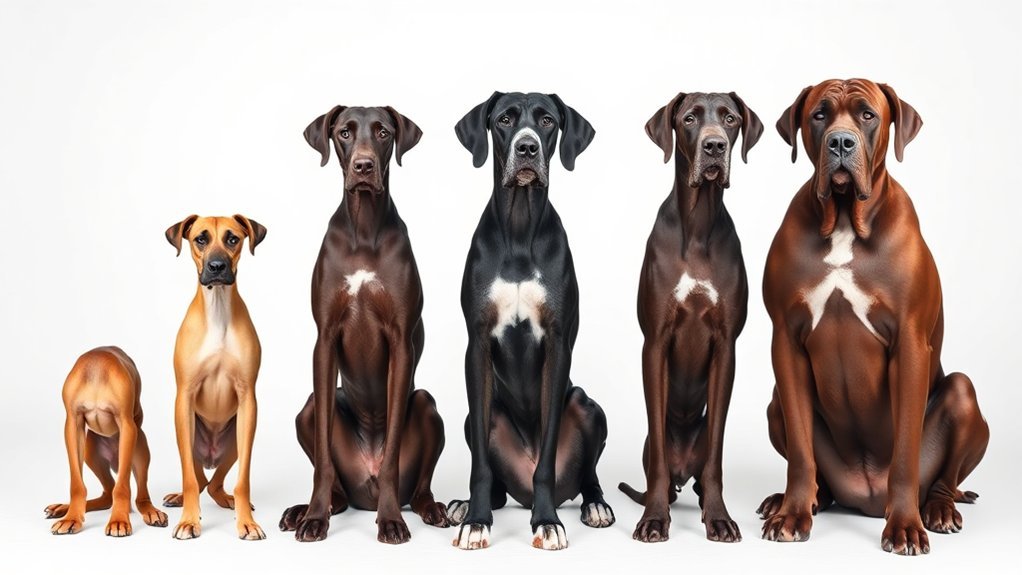

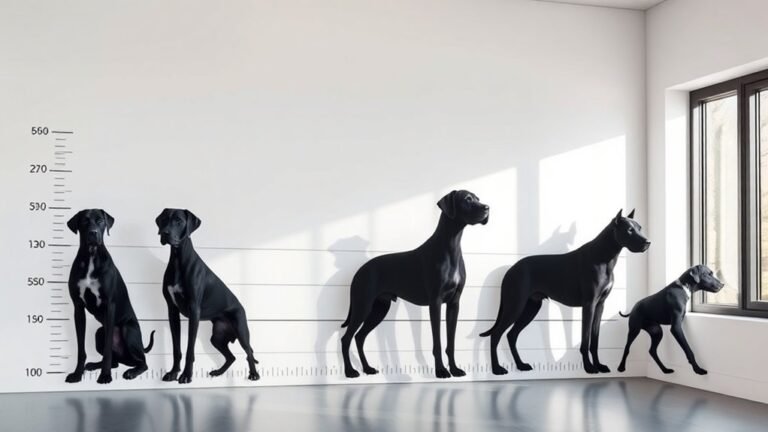
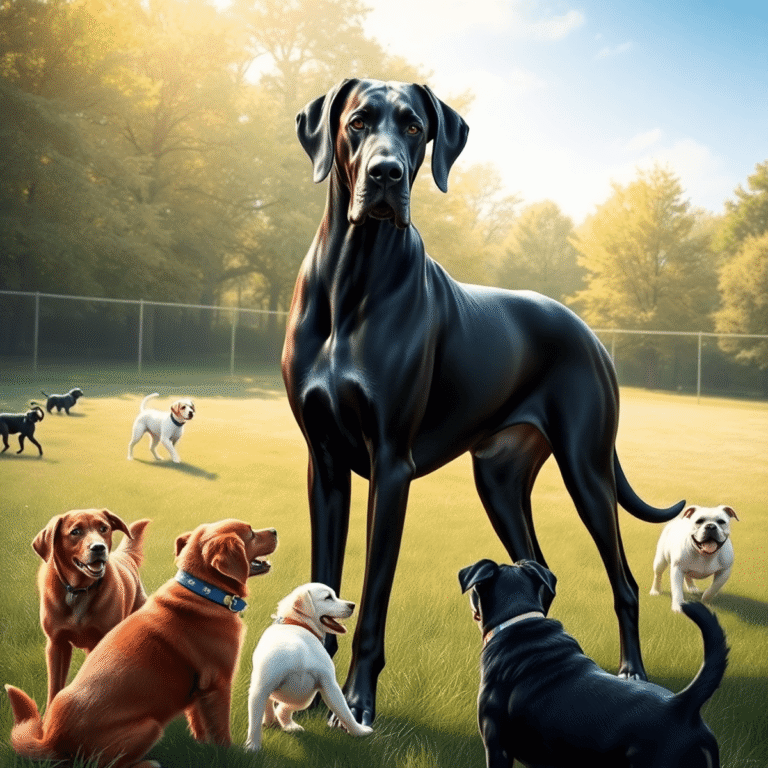
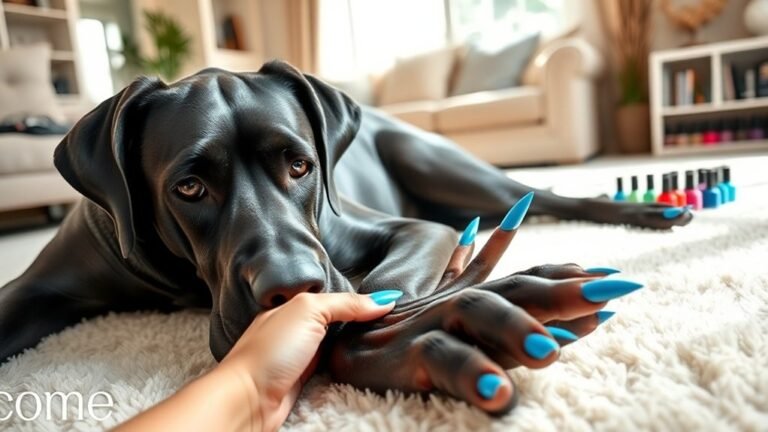
9 Comments